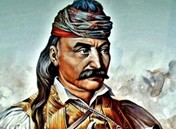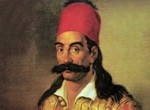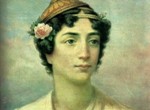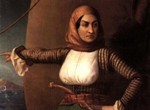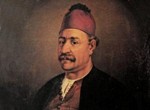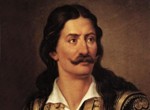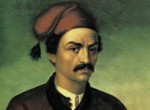Heroes of 1821
The 25th of March 1821 marks the beginning of the Greek revolution and 22 March 1829 the day of the creation of the modern Greek state. Presented below are some of the key heroes of that revolt. Their common characteristics were that the Divine flame lit their souls, and that their fierce patriotism was inspirational to all. A number of these heroes became members of the “Filiki Etairia” (Society of Friends), which was a major world-wide underground Greek revolutionary movement that was led by by Alexander Ypsilantis at the time of the revolution.

Gregory V of Constantinople was the 234th Patriarch of Constantinople. He was martyred in 1821 during the Greek War of Independence and was glorified as a saint by the Church of Greece 100 years later in 1921. He was born Georgios Aggelopoulos in Dimitsana, Arcadia prefecture in 1746, of pious parents. He was a studious child and his educational success took him to: Athens; the Smyrna theological school; and at Patmos after he had been tonsured a monk and named Gregory. Gregory returned to Smyrna and was ordained a deacon in 1775. He subsequently became an archdeacon, a priest and an assistant Bishop. In 1785 he was elected Bishop of the Metropolis of Smyrna, succeeding Procopius who had become Patriarch of Constantinople. Gregory was elected to the patriarchal throne of Constantinople served as Patriarch for three separate periods: 1797 to 1798, 1806 to 1808, and 1818 to 1821. His third and final period was a crucial and tense time in the Greek struggle for independence.
In 1818, Gregory provided his support to the Filiki Etairia that was preparing for a revolt against the Turkish rule. In reprisal for the society’s leader, Alexander Ypsilantis, crossing the Prut River and starting the Greek revolt in Romania, followed by the revolt in the Peloponnese, Gregory was arrested during the Divine Liturgy in Holy Week of April 1821. He was hanged on the front gate of the Patriarchate compound in his full Patriarchal vestments. After hanging for three days and being mocked by the passing crowds, his body was taken down and given to a group of Jews who dragged it through the streets of Constantinople before throwing it into the Bosphorus Sea. Gregory’s body was recovered from the sea by Nicholas Sklavos, who was a Greek captain of a Russian ship, and secreted to Odessa, then in Southern Russia, where it was buried with honours at the Church of the Holy Trinity. Later, his relics were enshrined in the Metropolitan Cathedral in Athens.
Theodoros Kolokotronis (1770-1834) is one of the most significant figures of the Greek War of Independence. He was the brain of the revolution and the animating spirit of the Greek nation. He came from a family with a long history of fighting Ottomons, and escaped to Zakynthos where he served in the English Army. He returned on the eve of the revolution. Due to his military experience and knowledge he soon became the leading figure in organising the Greek fighters. He led the siege of Tripolis, and its surrender marked the first success of the Greek revolution. He has gone down in history for his great success in the defeat of the Ottoman army under Mahmud Dramali Pasha at the Battle of Dervenakia, where he displayed his fierce courage, determination, patience, and military acumen. His political opponents imprisoned him but freed him when Ibrahim invaded Greece. Kolokotronis inflicted major blows to the invaders through guerrilla tactics, and was appointed commander-in-chief of the Greek forces in the Peloponnese in 1825.
He was a deeply religious man, a virtuous leader who believed ardently in the freedom of the Greek nation, placing his ideas and principles above all. He taught the Greeks to love each other and to fight against the common enemy. He forgave all of his enemies who had done harm to him or his family because he wanted the Greeks to be united. He was illiterate for most of his life but he was a gifted strategist. Three words could characterize his spirit: prudence, providence and wisdom. He later prompting the new generation to rebuild the world that they liberated with religion, solidarity and freedom.
Georgios Karaiskakis (1782-1827) was a famous brigand, military commander and hero of the revolution. He was born in a monastery near the village of Mavrommati in the Agrafa mountains. He grew up in poverty and at a young age was forced to the mountains, joining the service of Katsantonis, a local brigand. He was cunning, brave and reckless, rising quickly through the ranks to become lieutenant. He was one of the first to take part in the Greek revolution and his military genius became apparent during the last years of the struggle. The first Greek government appointed him as chief marshal of eastern Greece. He made Elefsina his headquarters. He was defeated when he sought to cut off Turkish supplies during the siege of Acropolis. His initial failures were followed by two famous victories at Arachova and Distomo. He was killed on 23 April, 1827, after he was fatally wounded by a rifle bullet in battle with the Turks at Faliro. After Kolokotronis, Karaiskakis is considered the revolution’s second most important military figure.
Germanos III of Old Patras (1771–1826), was born Georgios Gotzias in Dimitsana, northwestern Arcadia, Peloponnese. Before his consecration as Metropolitan of Patras by Patriarch Gregory V, he had served as a priest and Protosyngellus in Smyrna. He played an important role in the Greek Revolution, having diplomatic and political activity. According to tradition and several written sources, on the 25th March 1821 Feast of Annunciation Bishop Germanos proclaimed the national uprising against the Ottoman Empire and blessed the flag of the revolution at the Monastery of Agia Lavra.
Makriyannis was born Ioannis Triantaphyllou at Lidoriki and was later nicknamed ‘Makriyiannis’ (Long John) on account of his height. When in June 1825 Ibrahim Pasha attacked the Miloi of Argos with a force of 4,000 footsoldiers and 600 cavalrymen Makriyannis, together with Ypsilantis, Mavromichalis and 300 men, defended the position, which commands the approaches to Nauplion. They had already repulsed four fierce attacks by Ibrahim when, towards evening, they were reinforced by a detachment of the first regular Greek regiment. Its arrival decided the outcome of the battle, and the Turko-Egyptian forces retreated in great disarray, with heavy casualties. The gallant Makriyannis, who was gravely wounded in the fighting, was invited aboard the French Admiral de Rigny’s frigate, where he was received by the admiral.
At the battle of Faliron on 5 February, 1827, Makriyannis commanded the corps of Athenians, under the orders of General Gordon. He distinguished himself again and again in the defence of his position through his bravery in a number of engagements. After Greece’s Independence he had a tumultuous public career and played an important role in drafting the first Constitution to the Kingdom of Greece. Like Kolokotronis, he was sentenced to death but later pardoned. He is also famously known for his memoirs, which are a monument of Modern Greek literature.
Manto Mavrogenous was a heroine of the Greek revolution. She was born in Trieste, which was part of Austria, but is now located in Italy. She grew up in an educated family and studied ancient Greek philosophy and history, while also speaking fluent French, Italian and Turkish. In 1809 her family initially moved to Paros and later returned to Mykonos, the island of their origin. She learned with excitement from her father that the Philiki Etairia was preparing the Greek revolution. When the news arrived that the struggle for freedom had begun, Manto invited the leaders of Mykonos to a meeting and persuaded them to join the revolution. This was declared in April 1821. Manto was a wealthy woman and spent all her fortune for the freedom of the Greeks. She also managed to raise funds by getting her European friends to contribute money and guns to the Revolution.
Laskarina Boumboulina was another famous heroic woman of the Greek War of Independence. She was born in a prison cell in Constantinople and was the daughter of Stavrianos Pinotsis, a captain from Hydra. Boumboulina came from a rich family from the island of Spetses. She was involved with the undergound organisation Filiki Etairia, which worked towards the Revolution. She used her wealth to buy arms, ammunitions, and to build a navy which she said she did “for the sake of my nation.” After the success of the revolution in Peloponnesos and Central Greece, the uprising spread in the islands. Spetses was the first of the islands to join the revolution and this was mainly due to Boumboulina’s leadership and courage. The example of Spetse was followed by many other islands and therefore the freeing of the island of Spetse was one of the initial major steps towards victory for the Greeks. Thereafter Boumboulina, with her fleet, took part in many naval battles and dominated the Aegean creating problems for the by far superior Turkish fleet. Her daughter, Eleni Boubouli, later married the son of Kolokotronis, Panos Kolokotronis.

Rigas Feraios was a Greek writer, political thinker and revolutionary. He is remembered as a Greek national hero, a victim of the Balkan uprising against the Ottoman Empire and a pioneer of the Greek War of Independence. He wrote the Thourios (1797) or battle-hymn which every Greek at the time could relate to in which he wrote, “It’s finer to live one hour as a free man than forty years as a slave and prisoner.
Andreas Miaoulis (1769-1835) was an admiral and politician who commanded Greek naval forces during the Greek Revolution. He was born Andreas Vokos in Hydra, and was later nicknamed Miaoulis (ie. brainy one). At the age of 17 he became captain of a commercial ship. During the Napoleonic wars he showed courage in shipping wheat and corn. This enabled him to accumulate considerable wealth, which he used to contribute to the Turkish resistance in every way possible. He was appointed admiral of the Greek fleet in the revolution’s second year. He defeated the Turkish navy near Patra and the Turko-Egyptian navy near Geronda. On many occasions he was able to provide supplies for Greek cities besieged by the Turks (e.g. Mesologi). He lead Greeks to victory in skirmishes off Modon, Cape Matapan, Suda and Cape Papas.
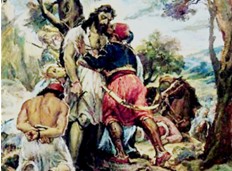
Papaflessas or Gregorios Dikaios (1788-1825) was a patriotic Greek, priest, government official, and a key figure of the Greek Revolution. He is remembered for instituting many reforms, establishing the Greek postal system and building many schools. He was born in 1788, in Messinia, Peloponnese. In his teenage years he became a monk, and was ordained an Archimandrite in 1818. The Turks forced him to leave Greece due to his revolutionary character. He was named Minister of Internal Affairs and chief of Police by the government of Prince Alexander Mavrocordato under the name of Gregorios Dikaios. This was his alias when serving with the “Filiki Etairia”, in which he became a key member. Under Ypsilantis’ orders he returned to the Peloponnese and started preaching the ideal of liberty and freedom to ferment rebellion, and prepare the people to revolt against the Turkish oppressors. In 1825 the Turks invaded yet again under Ibrahim with 6,000 French trained Egyptian troops. Papaflessas met him with a charge of 1,000 men. The battle that later claimed his life took place at Maniaki on 20 May 1825, where Ibrahim attacked the Greeks with a ten to one advantage and killed 600, including Papaflessas who fought bravely to the bitter end.
Athanasios Diakos was a great military commander. He was born Athanasios Nikolaos Massavetas and was the grandson of a local brigand. He was drawn to religion from an early age and went to the Monastery of St John the Baptist for his education. He became a monk at the age of 17 years and was ordained a deacon of the Greek Orthodox church not long after.
Constantinos Kanaris (1793-1877) came from the island of Psara. He blew up the Turkish armada at Chios and at Tenedos and other Turkish ships at Mytilene and Samos (1824). He was known in particular for his role in destroying the flagship of Turkish admiral Nasuhzade Ali pasha in revenge for the Chios massacre on the night of 6 June, 1822. There were 2,000 Ottoman casualties, including the pasha himself. He attempted to burn the Turkish ships at the port of Alexandria in order to destroy Mehmet Ali’s preparations against Greece and failed only due to the wind blowing from the opposite direction. Kanaris became one of the important naval figures of the revolution and was one of the few people to gain the trust of Ioannis Kapodistrias, the first Head of State of independent Greece. He became involved with politics opposing King Othon. He served several times as a minister and became prime minister. He was a brave, courageous and modest man.
Alexander Ypsilantis is considered to be one of the founders of Modern Greece. He suffered many tragedies during his lifetime and died in prison at the age of 35. His contributions to the history of Greece was important as they assisted in the establishment of an independent government in Greece in 1832, a few years after his death. Alexander Ypsilantis was born in Constantinople in 1792. His family fled to Russia when a war broke out between the Ottoman and the Russian Empires in 1805. In Russia Alexander learnt to speak fluently in French, Russian, German and Romanian. He spent much of his teenage years as a political refugee. He was invited to visit the Court of Tsar Alexander I of Russia. He joined a Russian military mounted brigade in 1808, when he was 16. During this period, the French army invaded Russia and Alexander Ypsilantis served in the Tsar’s military forces who opposed Napoleon. He lost his right arm during the fighting.
By the age of 25, Alexander Ypsilantis had become a general. He was later voted leader of Filiki Etairia. In 1820 he encouraged a rebellion in Wallachia and Moldova, Romania, after a powerful Ottoman warlord revolted against the Sultan. He hoped the insurgency in early 1821 would inspire revolutionaries in Greece to declare independence, and possibly receive Russian assistance. His four-month long military campaign failed to arouse widespread support. Authorities of the Austro-Hungarian Empire imprisoned him in Theresienstadt until 1827. Tsar Nicholas I arranged for his release, but he died in Vienna in early 1828.
Source: Lychnos April – May 2021

